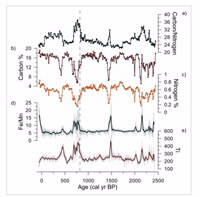
Environmental analysis carried out at ANSTO has been featured in a research spotlight in Earth and Planetary Science (EOS) online.
Prof Henk Heijnis, Leader Environmental Research, said that four staff (Gadd, Zawadzki, Saunders & Heijnis) from both the Isotope Tracing in Natural Systems and Environment groups at ANSTO were co-authors on the paper published in the Journal of Geophysical Research: Biogeosciences. The research was led by the School of Geography at the University of Melbourne.
A metre-long core of sediment from Lake Vera in Tasmania was collected by ANSTO scientists and was analysed at ANSTO, using the ITRAX X-ray fluorescence core scanner. It revealed interrelated changes in vegetation, pollen, charcoal, soil, and other components of the sediments over the past 2,400 years.
According to the report in EOS, they were particularly interested in the impact of fire, a major driver of ecosystem changes on land, on the aquatic ecosystem. Aquatic ecosystems, generally speaking, are highly sensitive and respond rapidly to environmental pressures.
 |
| XFR geochemical results from ITRAX d) Fe/Mn ration and e)Ti |
"Given the recent bushfire in proximity to ANSTO, although on a different scale, it serves as a reminder of the environmental impact of such events and the importance of understanding their significance in recapturing climate records," said Heijnis.
“We observe that a shift to drier conditions, known as El-Nino periods are usually associated with fire events. The effects of sudden shifts in the climate system are less well understood and this paper tries to address that gap” said Heijnis.
This study showed that a disturbance on land, such as a wildfire, can drive a critical transition in a lake within that ecosystem.
Read more: EOS
http://onlinelibrary.wiley.com/doi/10.1002/2017JG004135/full


